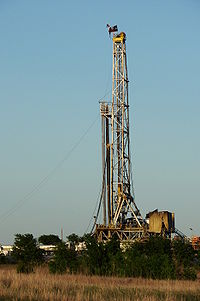| Fracking |
|---|
 |
| By country |
| Environmental impact |
| Regulation |
| Technology |
| Politics |
The environmental impact of fracking is related to land use and water consumption, air emissions, including methane emissions, brine and fracturing fluid leakage, water contamination, noise pollution, and health. Water and air pollution are the biggest risks to human health from fracking.[1] Research has determined that fracking negatively affects human health and drives climate change.[2][3][4]
Fracking fluids include proppants and other substances, which include chemicals known to be toxic, as well as unknown chemicals that may be toxic.[5] In the United States, such additives may be treated as trade secrets by companies who use them. Lack of knowledge about specific chemicals has complicated efforts to develop risk management policies and to study health effects.[6][7] In other jurisdictions, such as the United Kingdom, these chemicals must be made public and their applications are required to be nonhazardous.[8]
Water usage by fracking can be a problem in areas that experience water shortage. Surface water may be contaminated through spillage and improperly built and maintained waste pits, in jurisdictions where these are permitted.[9] Further, ground water can be contaminated if fracturing fluids and formation fluids are able to escape during fracking. However, the possibility of groundwater contamination from the fracturing fluid upward migration is negligible, even in a long-term period.[10][11] Produced water, the water that returns to the surface after fracking, is managed by underground injection, municipal and commercial wastewater treatment, and reuse in future wells.[12] There is potential for methane to leak into ground water and the air, though escape of methane is a bigger problem in older wells than in those built under more recent legislation.[13]
Fracking causes induced seismicity called microseismic events or microearthquakes. The magnitude of these events is too small to be detected at the surface, being of magnitude M-3 to M-1 usually. However, fluid disposal wells (which are often used in the USA to dispose of polluted waste from several industries) have been responsible for earthquakes up to 5.6M in Oklahoma and other states.[14]
Governments worldwide are developing regulatory frameworks to assess and manage environmental and associated health risks, working under pressure from industry on the one hand, and from anti-fracking groups on the other.[15][16]: 3–7 In some countries like France a precautionary approach has been favored and fracking has been banned.[17][18] The United Kingdom's regulatory framework is based on the conclusion that the risks associated with fracking are manageable if carried out under effective regulation and if operational best practices are implemented.[15] It has been suggested by the authors of meta-studies that in order to avoid further negative impacts, greater adherence to regulation and safety procedures are necessary.[19][20][21]
- ^ Urbina, Ian (15 May 2012). "Drilling Down". The New York Times. Retrieved 4 August 2020.
- ^ Bamber, AM; Hasanali, SH; Nair, AS; Watkins, SM; Vigil, DI; Van Dyke, M; McMullin, TS; Richardson, K (15 June 2019). "A Systematic Review of the Epidemiologic Literature Assessing Health Outcomes in Populations Living near Oil and Natural Gas Operations: Study Quality and Future Recommendations". International Journal of Environmental Research and Public Health. 16 (12): 2123. doi:10.3390/ijerph16122123. PMC 6616936. PMID 31208070.
- ^ Wright, R; Muma, RD (May 2018). "High-Volume Hydraulic Fracturing and Human Health Outcomes: A Scoping Review". Journal of Occupational and Environmental Medicine. 60 (5): 424–429. doi:10.1097/JOM.0000000000001278. PMID 29370009. S2CID 13653132.
- ^ Tabuchi, Hiroko (2 June 2021). "Here Are America's Top Methane Emitters. Some Will Surprise You". The New York Times. ISSN 0362-4331. Retrieved 7 June 2021.
- ^ Cite error: The named reference
house1was invoked but never defined (see the help page). - ^ Cite error: The named reference
EUwas invoked but never defined (see the help page). - ^ Cite error: The named reference
HassBenjaminwas invoked but never defined (see the help page). - ^ Cite error: The named reference
onshorewas invoked but never defined (see the help page). - ^ Cite error: The named reference
Surface Spillswas invoked but never defined (see the help page). - ^ Taherdangkoo, Reza; Tatomir, Alexandru; Anighoro, Tega; Sauter, Martin (February 2019). "Modeling fate and transport of fracking fluid in the presence of abandoned wells". Journal of Contaminant Hydrology. 221: 58–68. Bibcode:2019JCHyd.221...58T. doi:10.1016/j.jconhyd.2018.12.003. PMID 30679092. S2CID 59249479.
- ^ Taherdangkoo, Reza; Tatomir, Alexandru; Taylor, Robert; Sauter, Martin (September 2017). "Numerical investigations of upward migration of fracking fluid along a fault zone during and after stimulation". Energy Procedia. 125: 126–135. doi:10.1016/j.egypro.2017.08.093.
- ^ Cite error: The named reference
LoganJeffreywas invoked but never defined (see the help page). - ^ Cite error: The named reference
aea2012was invoked but never defined (see the help page). - ^ Cite error: The named reference
man-made-earthquakeswas invoked but never defined (see the help page). - ^ a b Cite error: The named reference
RoySocReportwas invoked but never defined (see the help page). - ^ Cite error: The named reference
EPAplanwas invoked but never defined (see the help page). - ^ Cite error: The named reference
autogenerated2was invoked but never defined (see the help page). - ^ Cite error: The named reference
autogenerated1was invoked but never defined (see the help page). - ^ Costa, D; Jesus, J; Branco, D; Danko, A; Fiúza, A (June 2017). "Extensive review of shale gas environmental impacts from scientific literature (2010-2015)". Environmental Science and Pollution Research International. 24 (17): 14579–14594. Bibcode:2017ESPR...2414579C. doi:10.1007/s11356-017-8970-0. PMID 28452035. S2CID 36554832.
- ^ Cite error: The named reference
PHE2014was invoked but never defined (see the help page). - ^ Tatomir, Alexandru; McDermott, Christopher; Bensabat, Jacob; Class, Holger; Edlmann, Katriona; Taherdangkoo, Reza; Sauter, Martin (22 August 2018). "Conceptual model development using a generic Features, Events, and Processes (FEP) database for assessing the potential impact of hydraulic fracturing on groundwater aquifers". Advances in Geosciences. 45: 185–192. Bibcode:2018AdG....45..185T. doi:10.5194/adgeo-45-185-2018. hdl:20.500.11820/b83437b4-6791-4c4c-8f45-744a116c6ead.